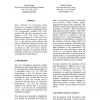Free Online Productivity Tools
i2Speak
i2Symbol
i2OCR
iTex2Img
iWeb2Print
iWeb2Shot
i2Type
iPdf2Split
iPdf2Merge
i2Bopomofo
i2Arabic
i2Style
i2Image
i2PDF
iLatex2Rtf
Sci2ools
DIAL
2004
IEEE
2004
IEEE
Document Style Census for OCR
Four methods of converting paper documents to computer-readable form are compared with regard to hypothetical labor cost: keyboarding, omnifont OCR, stylespecific OCR, and style-constrained or styleadaptive OCR. The best choice is determined primarily by (1) the reject rates of the various OCR systems at a given error rate, (2) the fraction of the material that must be labeled for training the system, and (3) the cost of partitioning the material according to style. For large corpora, sampling strategies are proposed both for estimating conversion costs and for taking advantage of style homogeneity.
| Added | 20 Aug 2010 |
| Updated | 20 Aug 2010 |
| Type | Conference |
| Year | 2004 |
| Where | DIAL |
| Authors | George Nagy, Prateek Sarkar |
Comments (0)

